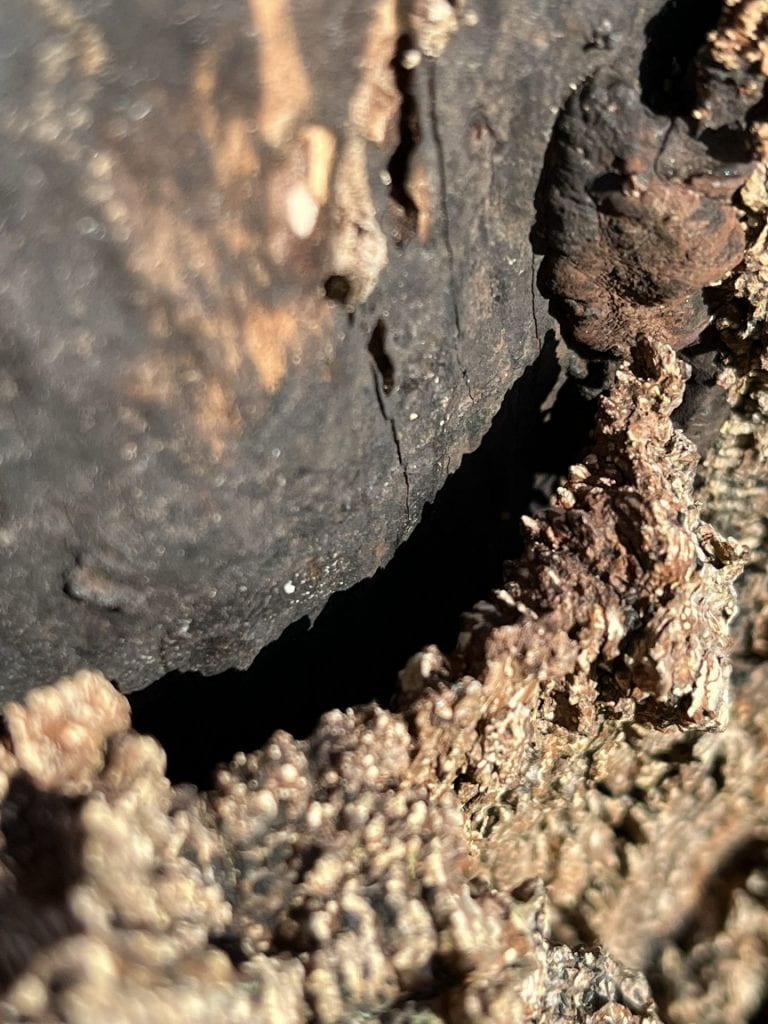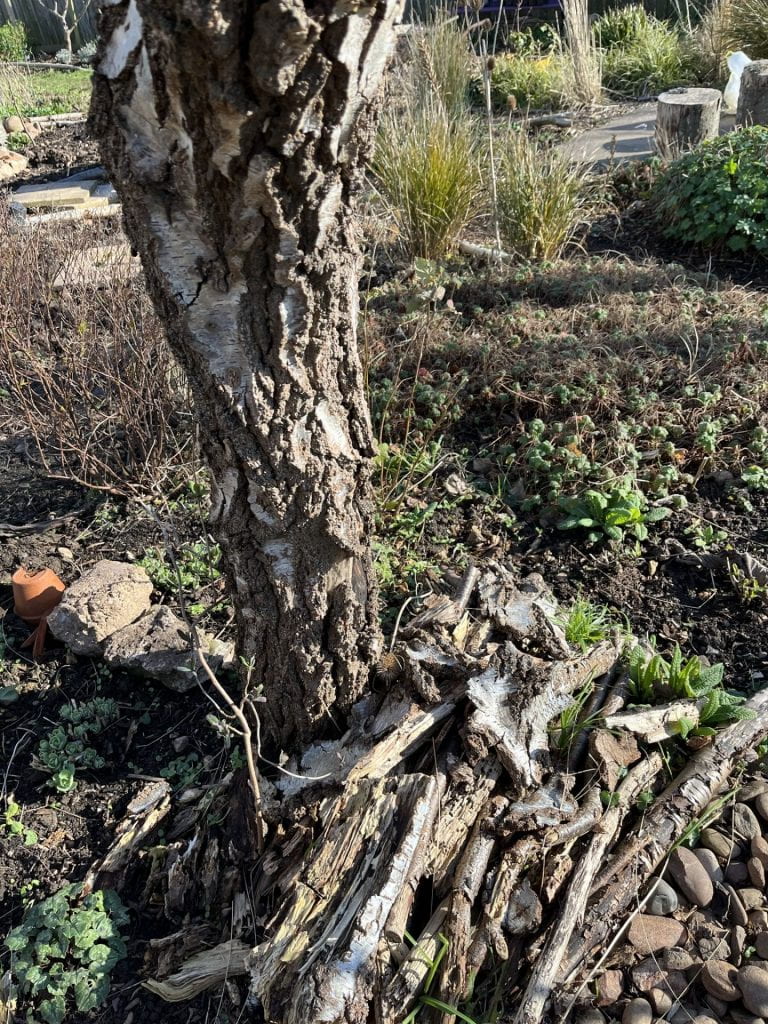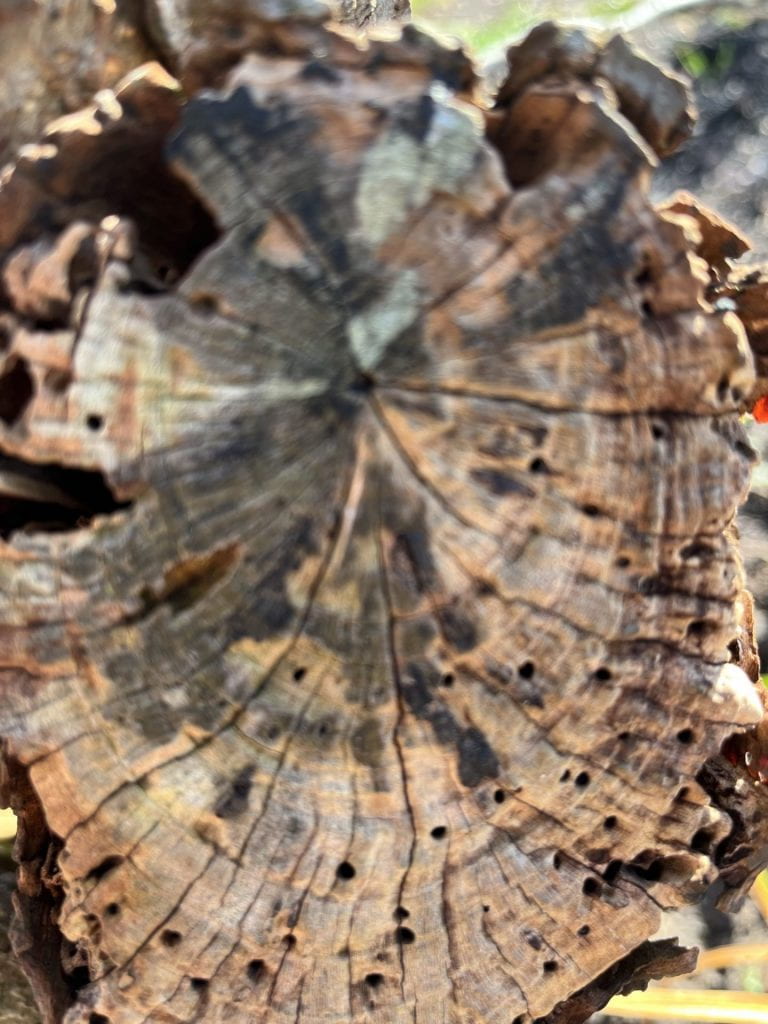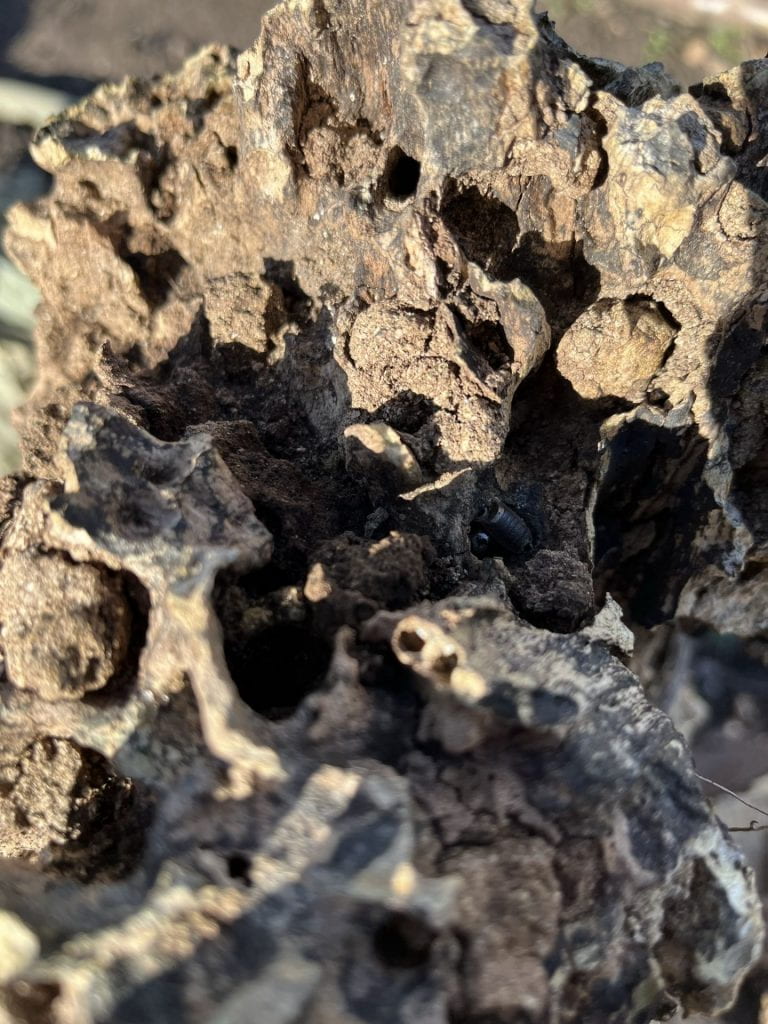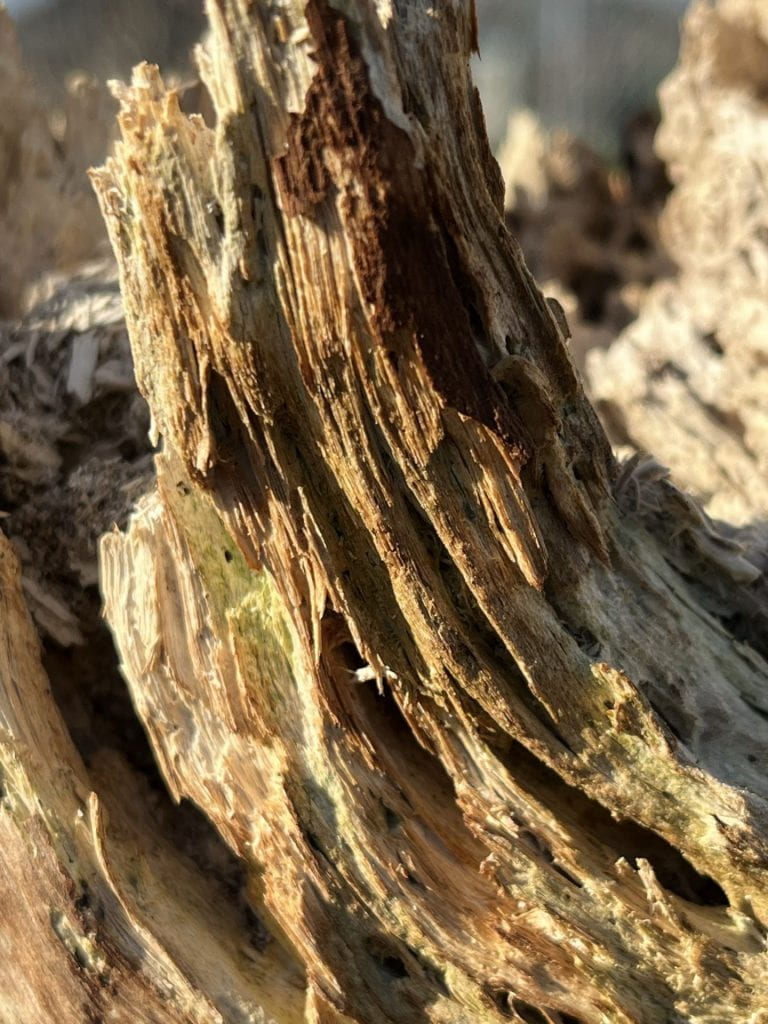Log piles on the wildlife plot no.3
When dead doesn’t mean dead!
I have written about the various log piles that are dotted around the wildlife plot and found a great graphic that shows who and what lives on dead wood so in this post I would like to look at the stages of decay in the log piles and what they look like.
There are several stages of decomposition in trees which this diagram clearly shows
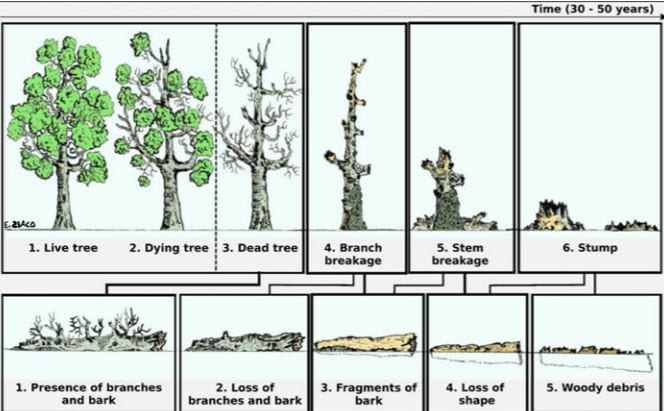
Stage 1 and 2 are living trees but stage 2 has a tree that is slowly declining with patches that are dead or severely damaged. Branches and twigs may break off but the tree is left intact and standing.
Stage 3 is a dead tree which is still standing but starting to sag and its texture is starting to soften. This is represented on the plot by the dead trees I have planted in the Thugs Bed.
Stage 4 is where the tree starts to lose its bark, sags to the ground and breaks into large pieces. Plant roots invade the sapwood. An example of this is the standing dead tree on the wildlife plot which is losing its bark through peeling and creating a heap on the floor which plants (weeds!) are starting to colonise.
This is not a planted dead tree but a dead tree that remained where it stood when alive, by far and away the best place for them to stay.
In stage 5 most of the tree is on the ground, in contact with the soil and decomposing by breaking into smaller, softer pieces. Roots of plants invade the heartwood. There isn’t any of this at present on the plot.
Stage 6 is the final stage where the tree is soft, powdery and basically a decomposed mound. We don’t have any of this either.
My understanding is that for a healthy forest you need trees at each stage of the decomposition process and whilst the plot is not a forest, each stage of decomposition has different fungi, lichens, invertebrates etc living on it and so it provides for the greatest diversity.
Fungi are the main agents of decay in wood, breaking it down with secretions of enzymes.
After the wood is softened, saproxylic beetles – those that feed on dead wood – and their grubs feed on the tree and on the fungal bodies on the tree. There are around 650 beetle species that are thought to need dead wood at some point in their life cycle. The tunnels and holes they make allow water to get into the wood and this softens it more and this is an invitation to the invertebrates such as woodlice and millipedes to feed on the wood. Predators and parasites such as robber flies and ichneumon wasps arrive to feed on the beetles and other invertebrates.
There are three main types of decay in dead trees; white rot, brown rot and soft rot. White rot breaks down the chemical components of wood into carbon and water, releasing nutrients such as nitrogen and phosphorus that were locked in the material. As the rot proceeds the wood takes on a bleached appearance, becoming fibrous and springy. The silver birch branches at edging the beds have rotted down like this and there is some at the top of the standing dead tree.
Brown rot only breaks down the simple sugars such as cellulose and the wood becomes brown, cracked into cubes and crumbly. Soft rot happens in environments where moisture content fluctuates such as wood lying on the ground. Lignin is broken down and the wood is white in colour.
The first picture shows cracking in the wood where the different fungi are working. The middle is holes in dead wood caused by beetles and their grubs and the third is an example of white rot in the standing dead tree.
See a short video about this process on post no.4
Have you got any decaying trees? What wildlife have you seen on them?
What and who uses dead wood
Following on from my post about log piles on the wildlife plot, I came across this brilliant graphic about dead wood and who feeds on it.
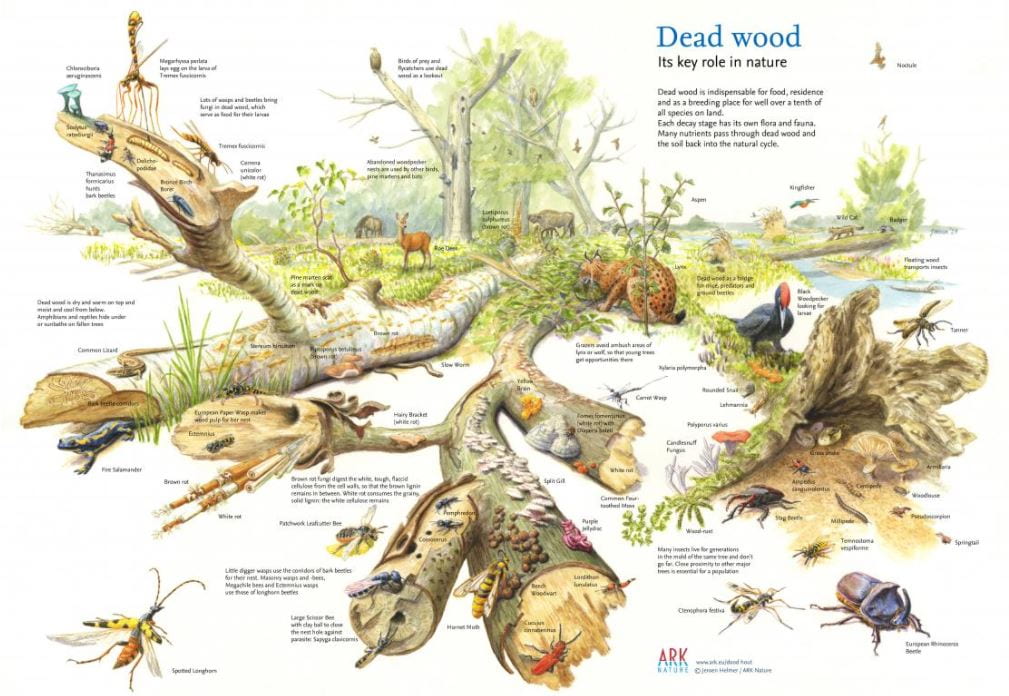
You can download a copy here – I used google translate to help me through the process as it was in Dutch. I don’t think I have the lynx and wolves but probably have many of the smaller species. I shall be keeping an eye out and trying to identify them across this year and then create my own version of this in December/January.
Bug hotels and hovels – Six on Saturday
I have a number of bug hotels and hovels built specifically for insects and slugs and snails to hide in on the wildlife plot. Without these we wouldn’t get the frogs and toads, slow worms and birds as the food web or chain won’t be complete.
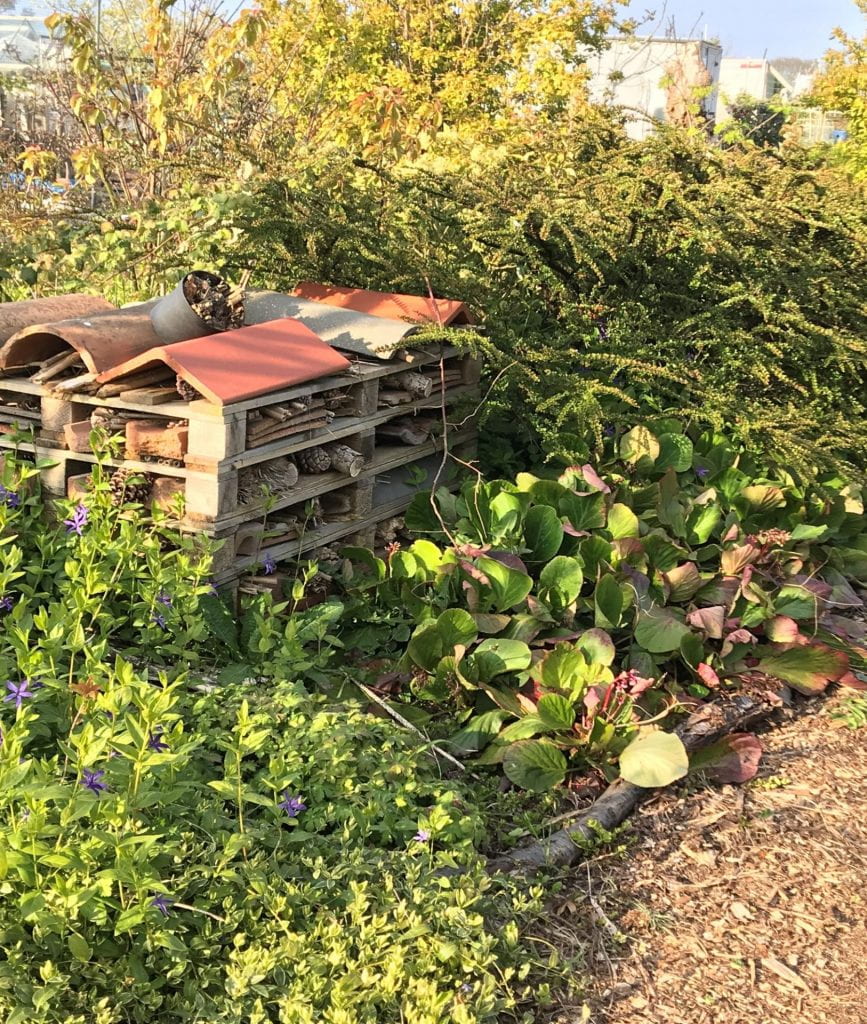
First of all we have the Hilton of bug hotels. I didn’t build this one – The Wildlife Trust did – and it has everything in it with a waterproof roof. This type of shelter can be a hotel for anything from hedgehogs to toads, solitary bees to bumblebees, and ladybirds to woodlice. I don’t like to ferret around in it so I don’t know what is in there apart from woodlice – lots of them! This just needs an occasional top up of materials and possibly rebuilding every few years. It is certainly a feature of the plot. The RSPB has a good set of instructions for creating one of these.
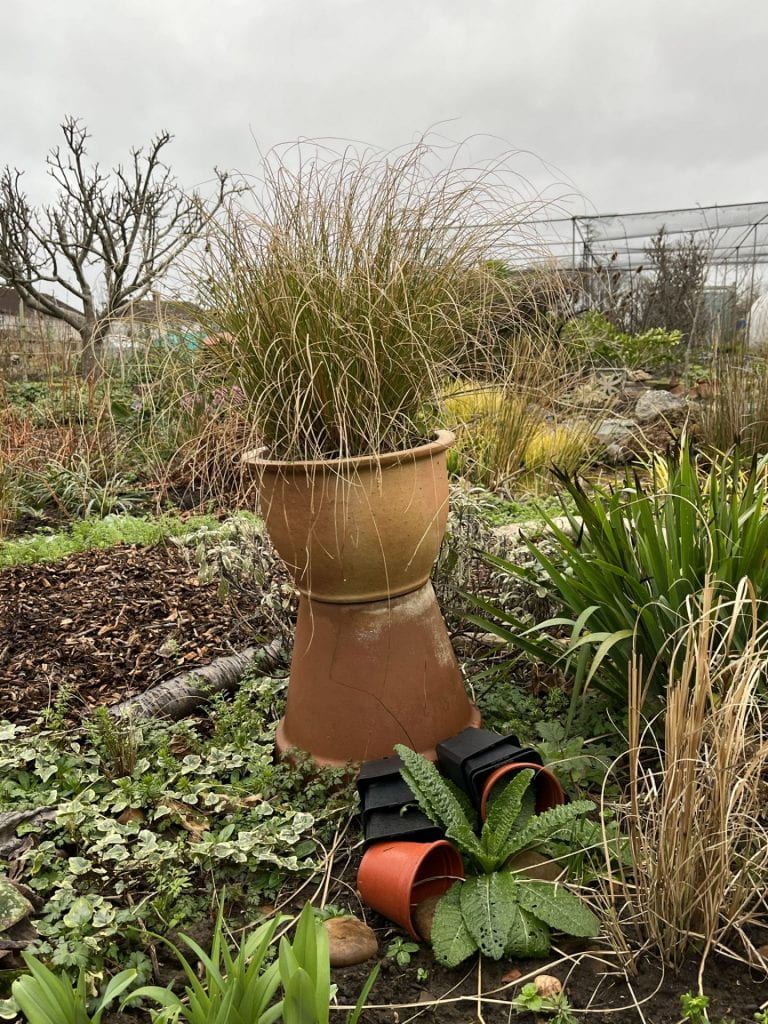
The flowerpot people are also bug hotels – more like Premier Inns than the Hilton – and suit slugs and snails. They are near the pond so that there is a food source for frogs and toads and slow worms in the summer when they are in the sun. They are extremely easy to build, no instructions needed and have grasses or pinks in the top pot as hair.
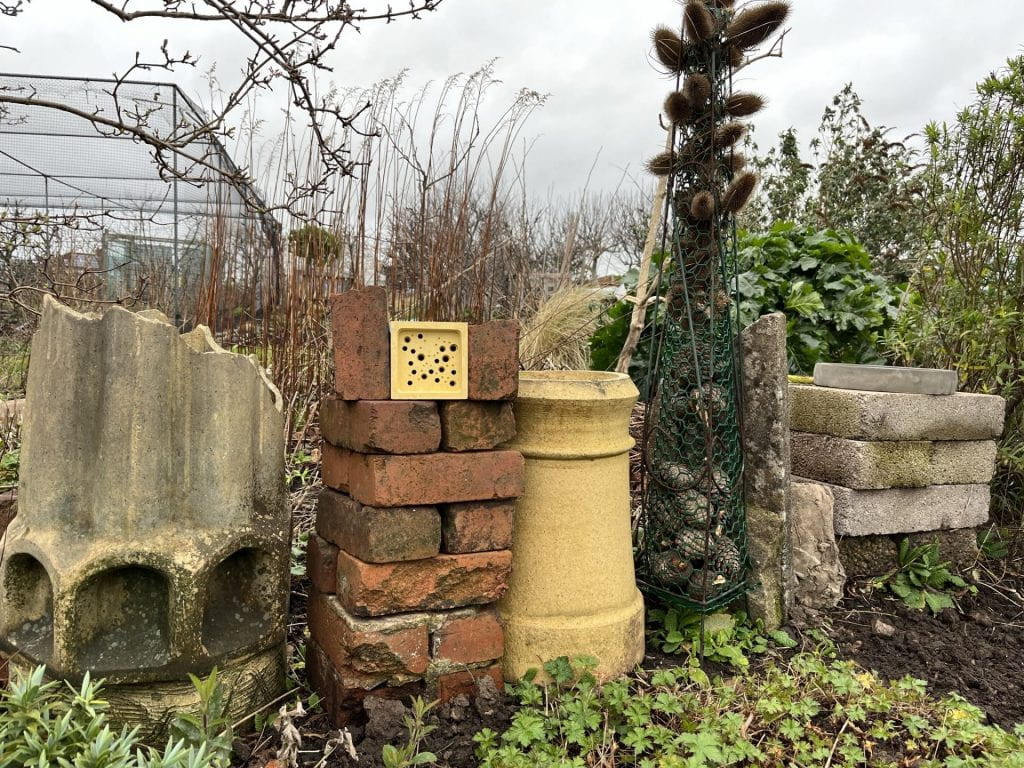
The next inn was made from a rusty plant support and a bit of netting stuffed with teasel heads and pine cones. I wrapped the netting inside the support and then stuffed the teasel heads down to the narrow end and then filled it up with the cones. To keep it all inside I placed a piece of the netting over the legs of the support and slid it up. Birds may well have a look at the teasels so I have stuck some outside the support as well making it look a bit peculiar. This is now sited in the taller end of the rubble wall that snakes through The Thugs Bed.
Someone left a Bee Brick on the bench for me. I looked them up and they need to be about 1m off the ground so built up a brick tower to sit it on, facing south. From everything I have read about solitary bees, you really need to clean out the tubes so I am not sure how well this will work but will give it a go.
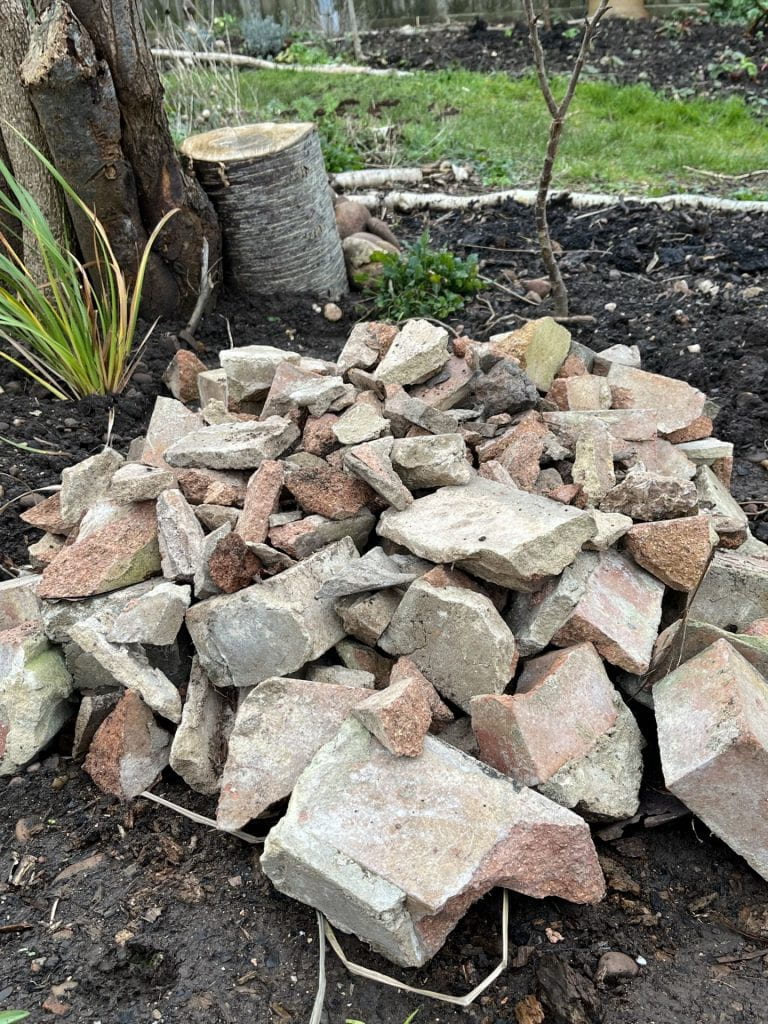
Then we have the rubble pile on the Brownfield Site Bed. This has logs, stones, dried grasses, water pipes leading in for solitary bees to go down and through, corrugated iron and then broken bricks on top. This is designed for a range of creatures and it will be interesting to see what uses it. This idea comes from John Little and shows how brownfield sites can be rich areas for insects and invertebrates meaning that building rubble does not have to be removed just shaped and repurposed appropriately saving a lot of waste.
As the weather warms up, this bed will be planted with yellow and white wildflowers or weeds depending on your point of view.
All this bed needs now is the mound of sand. I will use builders sand as part of the waste materials on a building site and it will be south-facing and specifically for solitary bees. It will be interesting to see what happens, if anything.
The next two bed and breakfast rooms are similar but look very different. They are the wall built out of waste building materials (not unlike the pile above) which offers lots of nooks and crannies and a stone filled gabion (quite small) with lots of gaps between the stones and warm enough in the sun to bask on. The gabion will have soil pockets put in and then plants popped in. I have a daisy, Erigeron karvinsianus, that someone has donated and no doubt I will never be without it after this.

On order is a solitary bee hotel with a viewing panel which will be fixed to a pole about a metre off the ground. You will be able to take the side off and look into the chambers to see what the bees are doing. This is mainly for the schools that visit the site but I suspect we will all be interested in it.
Have you got any bug hotels?
This post is linked to the #SIXONSATURDAY blog posts hosted by The Propagator
Harvest Monday 07/02/22
We have had a strange winter here on the south coast. Very little wind, evident from the fact that we have not had the sand blown off the beach and along the road at all this year, and little rain. That is not to say, however, that we haven’t had storms with a lot of wind and rain in one heavy drop. I do wonder if this is the future.
The downside of this is that the weather has been grey. Dreary and grey. The upside is that I have been able to do quite a bit of work outside in December and January. We had an official complaint about rats which is tricky as we border houses and have had to re-organise our plots to ensure that it isn’t us providing the perfect conditions for them. It turned out it wasn’t but we have all had to move our compost bins and other detritus from the bottom of our plots and store it elsewhere. I found carpet under the soil, a burial pit of plastic bags, many, many tree and bramble roots plus all my poles and wood. I also had to move 5 large compost bins most of which were ready to use and that has been strenuous but warming work.
From the store we have been pulling out potatoes – we’re still eating Charlotte – and carrots which are a mixture of Autumn King and Oxheart. We are also valiently working our way through a Queensland Blue squash that is delicious with a firm flesh but is quite large and has lasted for about 3 weeks already. Memo to self – eat more squash!
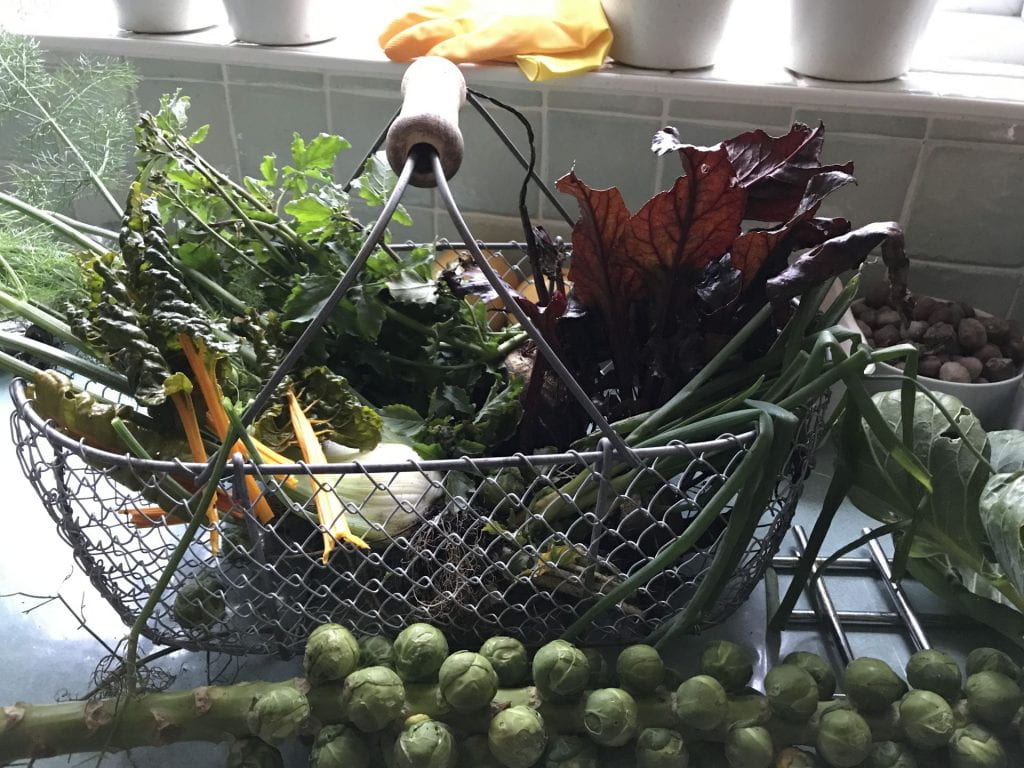
From the plot we have Brussel sprouts and Kalettes, Parsnips (Tender and True), lettuce (Rouge Grenoble), lambs lettuce (Vit) rainbow chard, Boltardy and Bona beetroot and fennel from the tunnel.
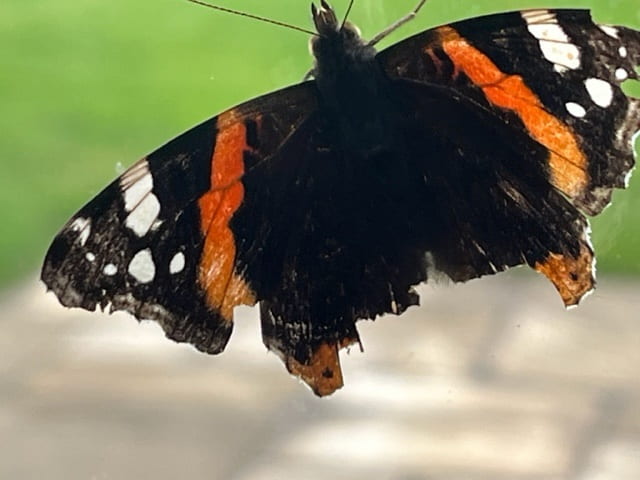
When I brought the veg in yesterday, a Red Admiral came in with them. Its wings look a little tatty at the edges, particularly the bottom so I think it must have over-wintered here as it is not really the right time for the migrating ones to arrive. Apparently, down here in the south that is happening more and more.
I put it outside but with a fairly heavy heart as it really wasn’t warm enough.
It is the first year that I have almost grown enough sprouts! I had 8 plants which I started picking at the beginning of December and still have a few left to go. I think 12 plants next year would be fantastic and I won’t have to ration them! They were of a good size probably because I grew F1 varieties – Crispus and Brodie – rather than open-pollinated which seem to be a lot more variable. I have been trying to grow more OP vegetables but sometimes F!s are better. Food is becoming a lot more expensive here for a variety of reasons so getting the best crops is more important.
I’m off to finish the bug pit on the wildlife plot before seed sowing starts in earnest. Have a good week.
I have linked to Harvest Monday on the Happy Acres blog. Do visit to see what else is being harvested around the world.
Log piles I have built
Log piles are a really important part of a wildlife garden for a variety of reasons.
- They provide shelter and a habitat for many insects, beetles, birds and reptiles.
- As the wood rots down, it creates space to put more on top so offering a way of getting rid of twigs, branches, trunks and everything in between.
- They can sit quietly where no one notices or they can be a designed feature of the garden – they can be large or small.
Here are a selection that we have on the wildlife plot – all built slightly differently.
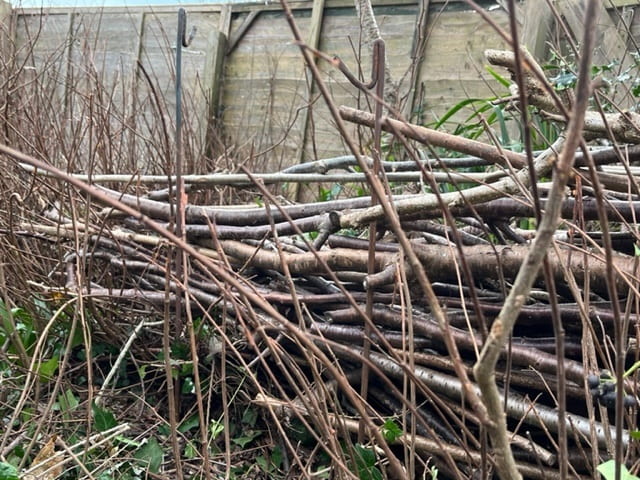
My first log pile is a dead hedge or what some people call a brash pile. I have used metal rods to provide a support to contain the branches and then laid them reasonably neatly along the length of the supports. I intend to increase the length of this dead hedge with hazel supports to provide a boundary between the plot and my garden neighbour. Dead hedges do not have to follow a straight line but can weave and snake around. On the plot ivy is starting to grow through and over it, providing even more shelter for whoever uses it. The whippy growths at the front of it are elm roots running and sprouting as the dead elms are cut down. There are some nice examples of dead hedging here.

The second log pile is probably what most people think of as a log pile. This one consists of trees cut down and then stacked in situ. We had to cut several cherries and dead elms down just to open up the site a little and to prevent too many of one particular thing taking over. Someone will use the bigger chunks as firewood eventually but here they sit, providing shelter for now. You can make excellent decorative piles with logs such as those created by Nigel Dunnett in what he calls wave form log piles. They look stunning when the plants are in flower and as they die down. I think for those structures, the logs are better if all cut to the same length, spread out and then you can choose which ones to put on the base and make use of the smaller and smaller branches as you go build up.
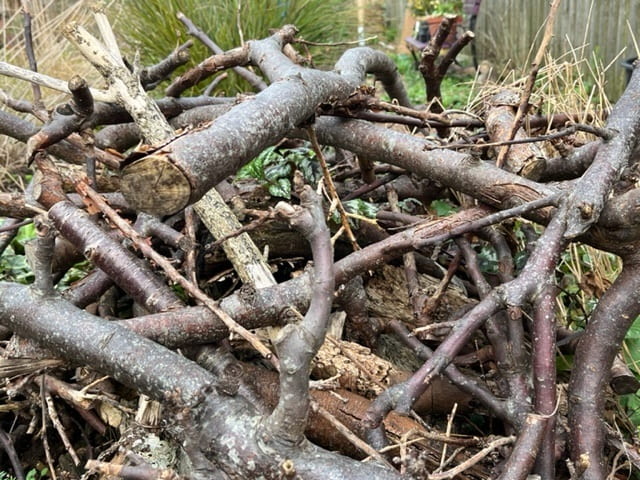
Next up is a log pile that was already on the plot when I started to work on it. This is in a shady corner and made out of awkward shaped bits of branches usually with 2 or 3 smaller branches coming off them. This is a good place to put the knobbly bits. The pile has been here long enough for dead nettle and harebells to grow through and around it. It is at the bottom of the bed near the pond and I do wonder who uses it – are the newts sheltered in there? I have seen a toad sitting in there a couple of years ago.
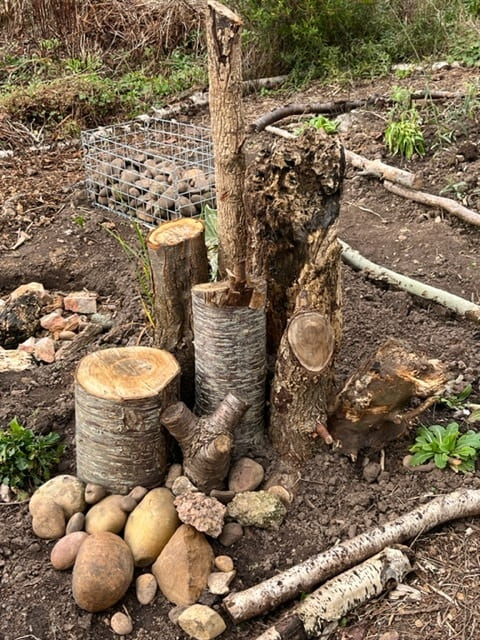
This is my latest log pile. It is in the Brownfield Site bed and rather than lay the logs down on their side, I have stood them up on end. I dug a pit about 30 – 40 cms deep and then buried the logs in it. This log pile is in full sun so will be used more by insects and others that like to bask. The stones at the base also provide a basking site so we will see who visits when we get a bit of sunshine.
I have also gone one step further in other parts of the wildlife plot and planted dead trees. They have peeling bark, some have woodworm and other creatures who have already attacked them but dead wood is dead wood and they will crumble and rot away just like a wood pile. They may also, however, offer perching places for birds. The tree I have planted are from dead elder and a Euonymus europaeus that blew down in storm Arwin.
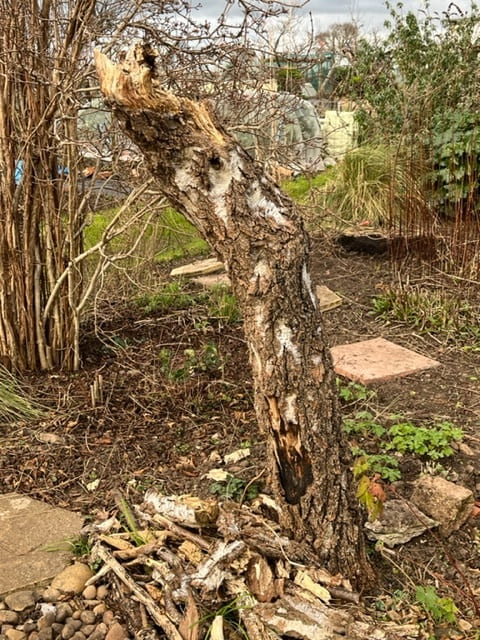
And, finally the last wood pile was already on the plot so I didn’t build it. Leave a tree trunk of a tree that you no longer need. It will rot and decay and bits will fall off creating quite a nice pile at the base. This is a fascinating process to watch. There are all sorts of woodlice and spiders living in the peeling bark and something is very neatly shredding the top of the trunk. It would make a good study and one I might do later on in the year just to see who is using it. @grassroofco uses trees in this way.
Have you got any log piles? Who or what uses them?
You can see posts two, three and four in the log pile series here.
